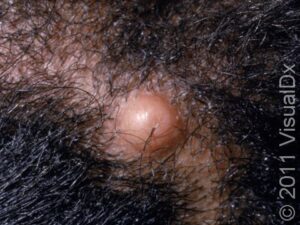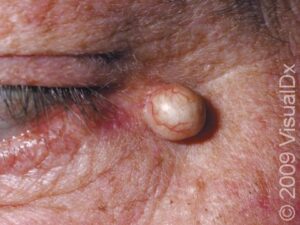What Is Cyst Excision, and What Is it For?
Skin cysts (eg, epidermoid cysts and pilar cysts) consist of sacs that are often filled with a foul-smelling, white, cheesy material. Cysts do not always need to be removed, especially if they’re not painful or cosmetically bothersome to you, but if a cyst becomes large or irritated, if it starts to cause you embarrassment, or if there is some sort of medical concern associated with the cyst, it’s best to have it removed.
Cyst excision is the technique by which a cyst, including the cyst sac, or wall, is surgically removed. It can often easily and safely be performed during a same-day office visit.


If the cyst is infected, your medical professional will first have you take medication such as an antibiotic to clear up the infection prior to removal. Similarly, if the cyst is inflamed, the inflammation needs to settle prior to removal. Your medical professional can usually inject a steroid into the cyst to help lessen swelling and inflammation. Then, the cyst can safely be removed by your medical professional.
If you believe you have a cyst but you haven’t yet seen a medical professional such as a dermatologist for diagnosis, it is important to seek medical care. Your medical professional will be able to confirm the diagnosis and help determine the best treatment in your case.
Note that you should never attempt to remove a cyst at home.
What Can I Expect During Cyst Removal?
After the medical professional cleans and sterilizes the area, they will numb the area with a local anesthetic such as lidocaine. Once the area is fully numb, the medical professional will make a small incision in the skin or use an instrument called a punch biopsy device to cut the skin. Then, the medical professional will remove the sac of the cyst through the small incision.
Once the cyst has been fully removed, the medical professional will stop the bleeding, and then they will close the incision with sutures. Your medical professional will let you know if the sutures will need to be removed in about 7-10 days or if they can be left in place to slowly “dissolve,” if they are absorbable sutures.
What Can I Expect Following Cyst Removal?
Following cyst removal, the area should look much smaller and flatter than it did previously. Following the cyst excision, there may be minor oozing or bleeding. If so, you can apply a clean gauze pad to the area and place pressure on it for 5 to 10 minutes. There may be pain after the local anesthetic wears off, but this is usually easily controlled with a pain reliever such as acetaminophen (eg, Tylenol).
A scar will occur where the incision was made, but typically there will just be a small, smooth scar.
What Follow-up Care Should I Take Following Cyst Removal?
Your medical professional will explain at-home wound care instructions.
As a general rule, you will want to:
- Keep the area dry during the first 24-48 hours.
- Apply petroleum jelly (eg, Vaseline) or antimicrobial ointment daily.
- Keep the area covered with gauze dressing or an adhesive bandage.
If you need to have sutures removed, be sure to follow up with your medical professional.
What Are the Risks and Potential Side Effects Associated with Cyst Removal?
There is some chance of:
- Infection.
- Bleeding during or after the surgery.
- Bruising.
- Scarring – Typically there is a small scar, but sometimes a keloid forms, which is a thick, raised scar.
There is also a risk of cutting an important structure such as vessels or nerves, depending on the location and size of the cyst.
What Else Should I Know about Cyst Removal?
Be sure to see your medical professional if your cyst comes back and is bothersome to you or if you develop signs of infection (such as pain, spreading redness, or fever). Usually, though, the cyst shouldn’t come back, and you should have little to no downtime following cyst removal. It is a safe procedure with few risks, especially when in the hands of a professional such as a board-certified dermatologist.
Last modified on February 6th, 2025 at 1:15 pm